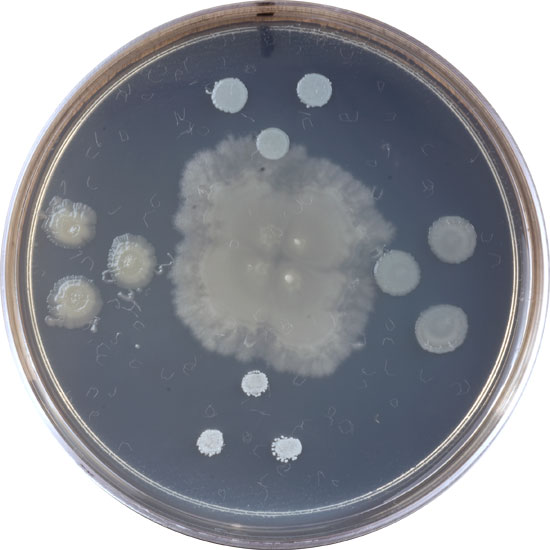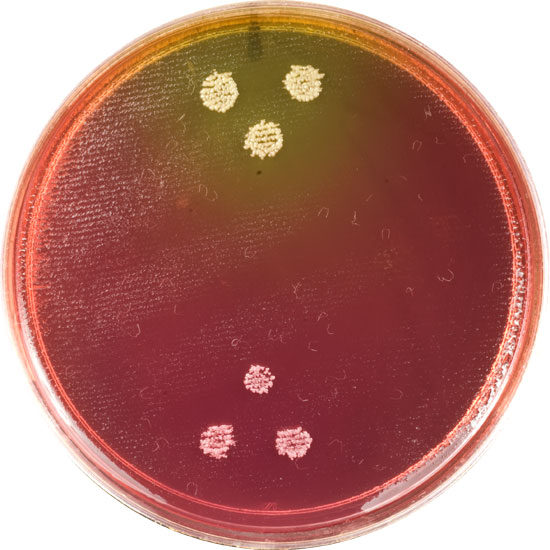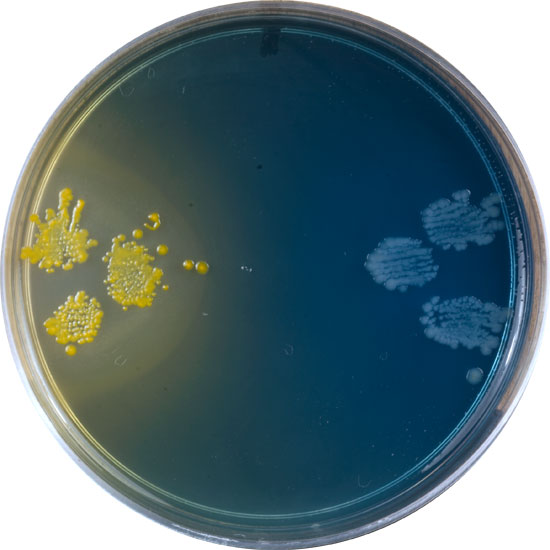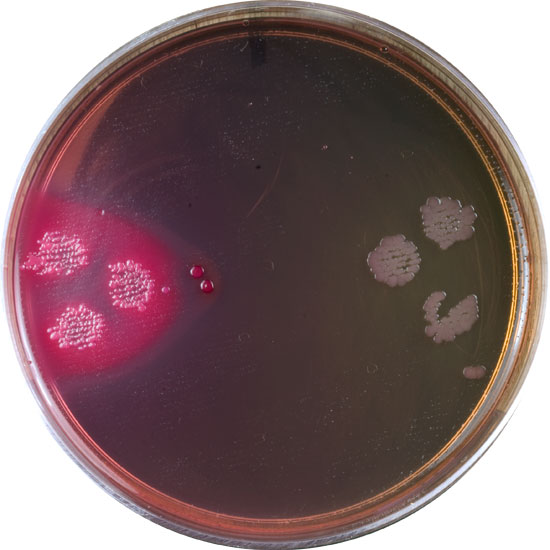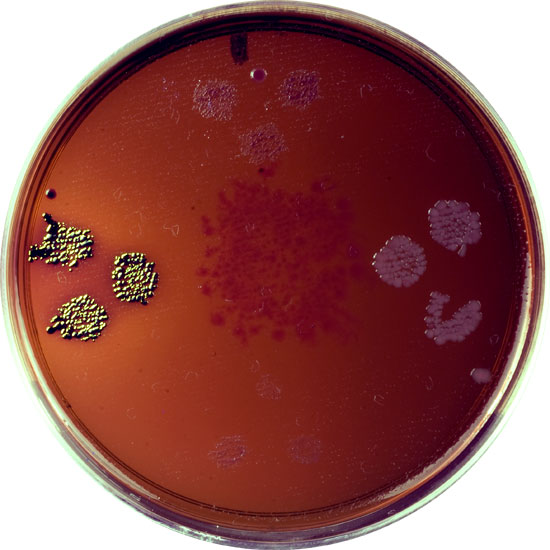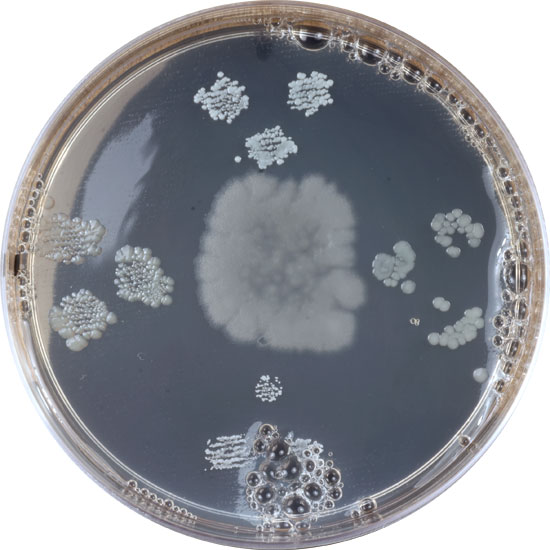![]()
Use of Selective and Differential Media and Replica Plating:
Selective media promote the growth of certain types of microorganisms while inhibiting the growth of others.
Differential media allow multiple different types of microorganisms to grow, but cause them to differ in their appearance when they do.
Replica Plating is a method or technique used to transfer a colony pattern from one plate to several other plates quickly and easily.
|
Master Plate
|
Replica Master Plate The replica master plate contains nutrient agar that was inoculated with five different types of bacteria. The three colonies at the top of the plate are Staphylococcus aureus, those at the bottom of the plate are Staphylococcus epidermidis, those on the left are Escherichia coli, those at the right are Salmonella choleraesuis, and those in the center of the plate are Bacillus cereus. A velvet covered block was used to transfer the colony pattern from this plate onto a series of plates containing selective and differential media. The last plate in the series was again nutrient agar. |
|
Manitol Salt Agar
|
Manitol Salt Agar Mannitol salt agar or MSA contains 7.5% NaCl, the carbohydrate mannitol, and the pH indicator phenol red. The high salt content makes this medium selective for halophiles. In this case, only the Staphylococcus species were able to grow. The colonies of Staphylococcus aureus at the top are surrounded by a yellow zone, indicating they are able to form acid by fermenting the mannitol. The Staphylococcus epidermidis are surrounded by a red or pinkish zone, indicating they are unable to ferment the mannitol. Salmonella colonies are often capable of growing on this medium, but are not present here. |
|
Tergitol-7 Agar
|
Tergitol-7 Agar Tergitol-7 agar or T-7 contains chemicals that inhibit the growth of Gram-positive bacteria, but will generally support the growth of (will select for) Gram-negative organisms. The pH indicator in this medium is bromothymal blue, and the carbohydrate present is lactose. The Escherichia coli colonies on the left side of the plate have produced acid through the fermentation of lactose, and have caused the pH indicator to change from green (neutral) to yellow. The Salmonella colonies on the right side of the plate have produced alkaline end products by catabolizing the peptone in the medium, and have caused the pH indicator to change from green (neutral) to blue. Tergitol-7 agar is a good selective medium in that it fully inhibited the growth of the Gram-positive organisms deposited on its surface. |
|
MacConkey's Agar
|
MacConkey's Agar MacConkey's agar or MAC contains neutral red, crystal violet, and lactose. The crystal violet (a basic dye) inhibits the growth of Gram-positive bacteria, making the MacConkey's agar selective for Gram-negative bacteria. The Escherichia coli colonies on the left have produced acid by fermenting the lactose present, and have caused the neutral red to accumulate within and around their colonies. The Salmonella choleraesuis colonies on the right have caused the medium to fade from pink to tan, and are much less colorful. Non-fermenting colonies like Salmonella tend to be pale and translucent on this medium, while fermenting colonies tend to be bright pink and more opaque. MacConkey's agar is a good selective medium in that it fully inhibited the growth of the Gram-positive organisms deposited on its surface. |
|
Eosin Methylene Blue Agar
|
Eosin Methylene Blue Agar Eosin Methylene Blue agar or EMB contains lactose, eosin and methylene blue. Like Tergitol-7 and MacConkey's agar it contains lactose, and tends to inhibit the growth of Gram-positive bacteria. It is less effective at inhibiting the growth of Gram-positive organisms than are the other two media. The Escherichia coli colonies on the left side of the plate have produced acid by fermenting the lactose present and have formed dark colonies with a metalic green sheen (irridescent color). The Salmonella choleraesuis colonies on the right are unable to ferment the lactose, and appear more translucent and pale pink in color. Although their growth is poor, all three of the Gram-positive cultures transferred onto the surface of this medium have grown some. |
|
Positive Control
|
Positive Control The nutrient agar plate used at the end of the replica series demonstrates the effectiveness of the replica plating method. All five types of bacteria present on the replica master plate are also present on this plate. The colonies of Staphylococcus epidermidis at the plate bottom are partially obscured by bubbles in the medium. The large colonies at the center of the plate are Bacillus cereus. Although these organisms grow well on nutrient agar, they are not halophiles so will not grow on mannitol salt agar. These organisms are Gram-positive, so their growth is effectively inhibited by the chemicals in Tergitol-7 and MacConkey's agar. Their growth on Eosin Methylene Blue is minimal. |
Questions:
1. What are selective media, what are differential media, and are these media categories necessarily exclusive of one another?
2. What is replica plating, and what are the advantages of using this method for transferring colonies over a more traditional streak plate method?
3. Mannitol salt agar is selective for what types of bacteria? What is the pH indicator present, and how is this medium differential?
4. T-7, MAC and EMB are selective for what types of bacteria? What is the carbohydrate present in these media?
5. What characteristics do lactose fermenting colonies have on T-7, MAC and EMB and what characteristics do non-fermentative colonies have?
Copyright 2008 Sierra College Biological Sciences Department. All Rights Reserved.
![]()
![]()
